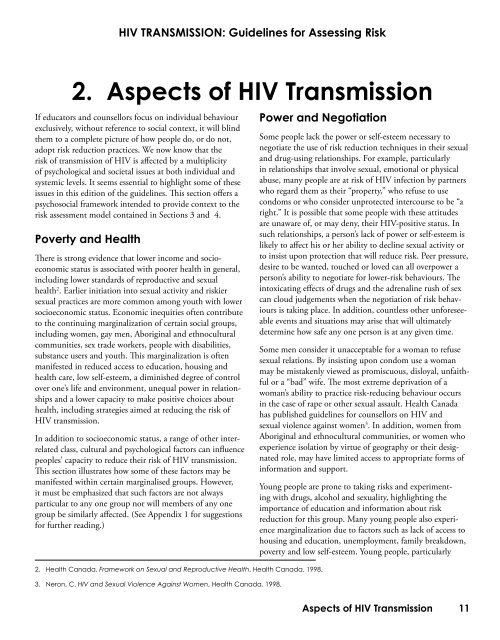HIV transmission: guidelines for assessing risk - Canadian AIDS ...
HIV transmission: guidelines for assessing risk - Canadian AIDS ...
HIV transmission: guidelines for assessing risk - Canadian AIDS ...
- No tags were found...
Create successful ePaper yourself
Turn your PDF publications into a flip-book with our unique Google optimized e-Paper software.
<strong>HIV</strong> TRANSMISSION: Guidelines <strong>for</strong> Assessing Risk2. Aspects of <strong>HIV</strong> TransmissionIf educators and counsellors focus on individual behaviourexclusively, without reference to social context, it will blindthem to a complete picture of how people do, or do not,adopt <strong>risk</strong> reduction practices. We now know that the<strong>risk</strong> of <strong>transmission</strong> of <strong>HIV</strong> is affected by a multiplicityof psychological and societal issues at both individual andsystemic levels. It seems essential to highlight some of theseissues in this edition of the <strong>guidelines</strong>. This section offers apsychosocial framework intended to provide context to the<strong>risk</strong> assessment model contained in Sections 3 and 4.Poverty and HealthThere is strong evidence that lower income and socioeconomicstatus is associated with poorer health in general,including lower standards of reproductive and sexualhealth 2 . Earlier initiation into sexual activity and <strong>risk</strong>iersexual practices are more common among youth with lowersocioeconomic status. Economic inequities often contributeto the continuing marginalization of certain social groups,including women, gay men, Aboriginal and ethnoculturalcommunities, sex trade workers, people with disabilities,substance users and youth. This marginalization is oftenmanifested in reduced access to education, housing andhealth care, low self-esteem, a diminished degree of controlover one’s life and environment, unequal power in relationshipsand a lower capacity to make positive choices abouthealth, including strategies aimed at reducing the <strong>risk</strong> of<strong>HIV</strong> <strong>transmission</strong>.In addition to socioeconomic status, a range of other interrelatedclass, cultural and psychological factors can influencepeoples’ capacity to reduce their <strong>risk</strong> of <strong>HIV</strong> <strong>transmission</strong>.This section illustrates how some of these factors may bemanifested within certain marginalised groups. However,it must be emphasized that such factors are not alwaysparticular to any one group nor will members of any onegroup be similarly affected. (See Appendix 1 <strong>for</strong> suggestions<strong>for</strong> further reading.)2. Health Canada. Framework on Sexual and Reproductive Health, Health Canada. 1998.3. Neron, C. <strong>HIV</strong> and Sexual Violence Against Women, Health Canada. 1998.Power and NegotiationSome people lack the power or self-esteem necessary tonegotiate the use of <strong>risk</strong> reduction techniques in their sexualand drug-using relationships. For example, particularlyin relationships that involve sexual, emotional or physicalabuse, many people are at <strong>risk</strong> of <strong>HIV</strong> infection by partnerswho regard them as their “property,” who refuse to usecondoms or who consider unprotected intercourse to be “aright.” It is possible that some people with these attitudesare unaware of, or may deny, their <strong>HIV</strong>-positive status. Insuch relationships, a person’s lack of power or self-esteem islikely to affect his or her ability to decline sexual activity orto insist upon protection that will reduce <strong>risk</strong>. Peer pressure,desire to be wanted, touched or loved can all overpower aperson’s ability to negotiate <strong>for</strong> lower-<strong>risk</strong> behaviours. Theintoxicating effects of drugs and the adrenaline rush of sexcan cloud judgements when the negotiation of <strong>risk</strong> behavioursis taking place. In addition, countless other un<strong>for</strong>eseeableevents and situations may arise that will ultimatelydetermine how safe any one person is at any given time.Some men consider it unacceptable <strong>for</strong> a woman to refusesexual relations. By insisting upon condom use a womanmay be mistakenly viewed as promiscuous, disloyal, unfaithfulor a “bad” wife. The most extreme deprivation of awoman’s ability to practice <strong>risk</strong>-reducing behaviour occursin the case of rape or other sexual assault. Health Canadahas published <strong>guidelines</strong> <strong>for</strong> counsellors on <strong>HIV</strong> andsexual violence against women 3 . In addition, women fromAboriginal and ethnocultural communities, or women whoexperience isolation by virtue of geography or their designatedrole, may have limited access to appropriate <strong>for</strong>ms ofin<strong>for</strong>mation and support.Young people are prone to taking <strong>risk</strong>s and experimentingwith drugs, alcohol and sexuality, highlighting theimportance of education and in<strong>for</strong>mation about <strong>risk</strong>reduction <strong>for</strong> this group. Many young people also experiencemarginalization due to factors such as lack of access tohousing and education, unemployment, family breakdown,poverty and low self-esteem. Young people, particularlyAspects of <strong>HIV</strong> Transmission11
















